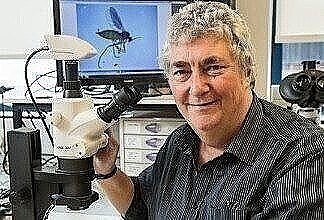
The Gardener’s Guide to Earwigs
3 Minute Read
Dr Ian Bedford tells us everything we need to know about the 'bug of the month' for July, the Earwig.What Are Earwigs? A Quick Introduction
Often found throughout the year amongst organic debris or within nooks and crannies around a garden are the insects that we call earwigs, which make up the taxonomic order called Dermaptera. Worldwide, there are around 2000 species that have been identified to date, with just four being native to Britain. And the most widespread of these being the Common Earwig, Forficula Auricularia.
Often found throughout the year amongst organic debris or within nooks and crannies around a garden are the insects that we call earwigs, which make up the taxonomic order called Dermaptera. Worldwide, there are around 2000 species that have been identified to date, with just four being native to Britain. And the most widespread of these being the Common Earwig, Forficula Auricularia.

Earwig Identification and Understanding Their Role in the Garden Ecosystem
Earwigs are one of the most easily identifiable insects that we find in our garden, displaying shiny brown bodies and a distinctive pincer at the end of their abdomen that they can use for defence. Earwigs are primarily a nocturnal scavenger that consume decaying plant material, carrion and aphids, and therefore should be recognised as beneficial within a garden ecosystem.
However, they are also known to nibble dahlia and chrysanthemum flowers and so might be considered a plant pest by some gardeners, but instead of using a lethal control method (unfortunately there are earwig-killing pesticides on the market), gardeners could always trap them alive by loosely filling empty bottles with strips of damp paper before inverting them on bamboo canes amongst the flowers. The nocturnally active earwigs will then crawl into the bottles as daylight breaks, from where they can be collected and relocated away from the flowers.

Parental Behaviour and ‘Wiglets’
Interestingly, earwigs are one of the very few species of solitary insects that exhibit parental behaviour, remaining with their eggs throughout the winter months, and then nursing their nymphs (the Wiglets) when they hatch during spring, through to maturity.

Are Earwigs Dangerous to Humans? Busting the Myths
Although earwigs are harmless to us, other than delivering a mild nip with their pincer if handled roughly, they were in fact feared by people during medieval times, since it was wrongly assumed that earwigs were venomous and that they spread diseases. In addition, it was also believed that whilst people slept, earwigs might crawl into their ears and burrow inside their heads! Which was the reason why they acquired the name Earwigs, Wig being the old English word for wiggler.
But this frightful belief wasn’t just held here within medieval Britain, but in France and Germany too, where they were called Ear Piercers and Ear Worms.
But this frightful belief wasn’t just held here within medieval Britain, but in France and Germany too, where they were called Ear Piercers and Ear Worms.
So, did earwigs ever deserve acquiring this rather disturbing reputation? Well, we’re astute enough nowadays to know that earwigs aren’t attracted to people when they’re asleep, and that if an earwig did ever accidentally crawl into somebody’s ear, it wouldn’t burrow into their head. But during medieval times, when it would have been common for people to sleep on the ground, it’s a possibility that once in a while, an earwig could have found the dark, moist environment of a human ear canal, a suitable place to enter and rest within during the day.

About Dr Ian Bedford
Ian has been fascinated by the bug world for as long as he can remember. From studying butterflies on the South Downs as a youngster, he went on to pursue a career in Research Entomology and ran the Entomology Dept at the John Innes Centre in Norwich up until his recent retirement.Visit website

'Bug of the Month'
Visit our 'bug of the month' archive.
Every month Ian will share his knowledge on how to protect your plants and gardens from preventable pest invasions while providing valuable insights into the insects regularly found in our gardens.
find out moreComments (0)
Why not be the first to send us your thoughts?
